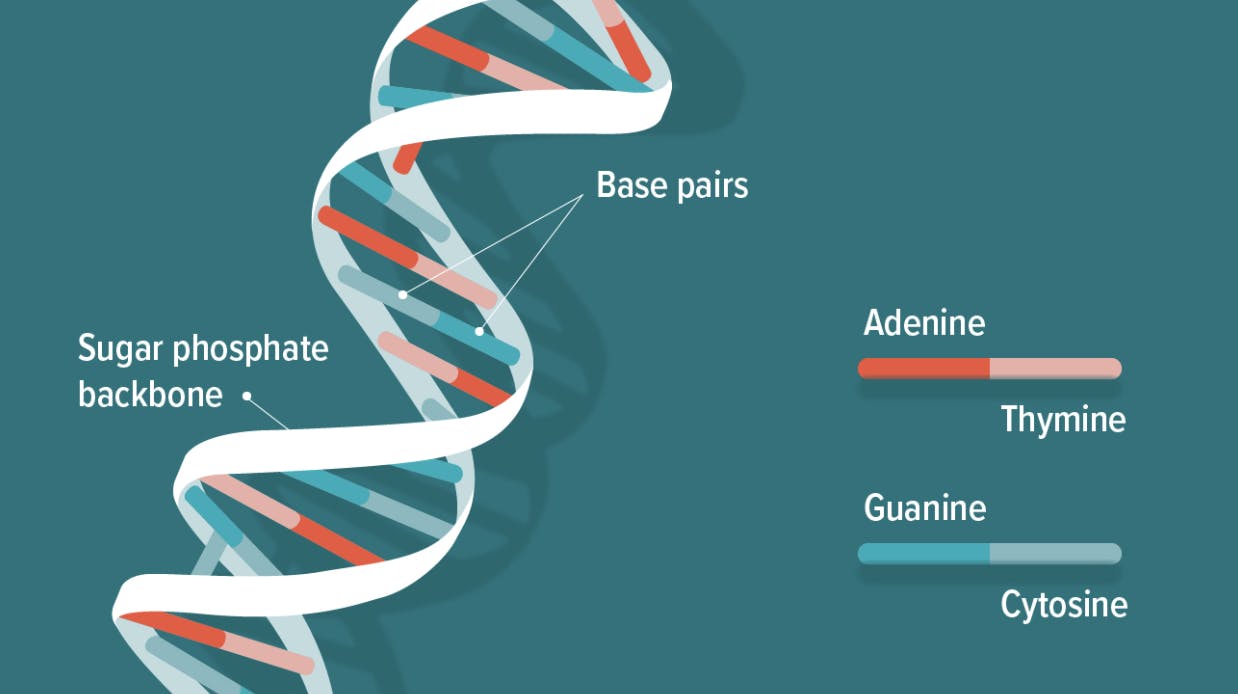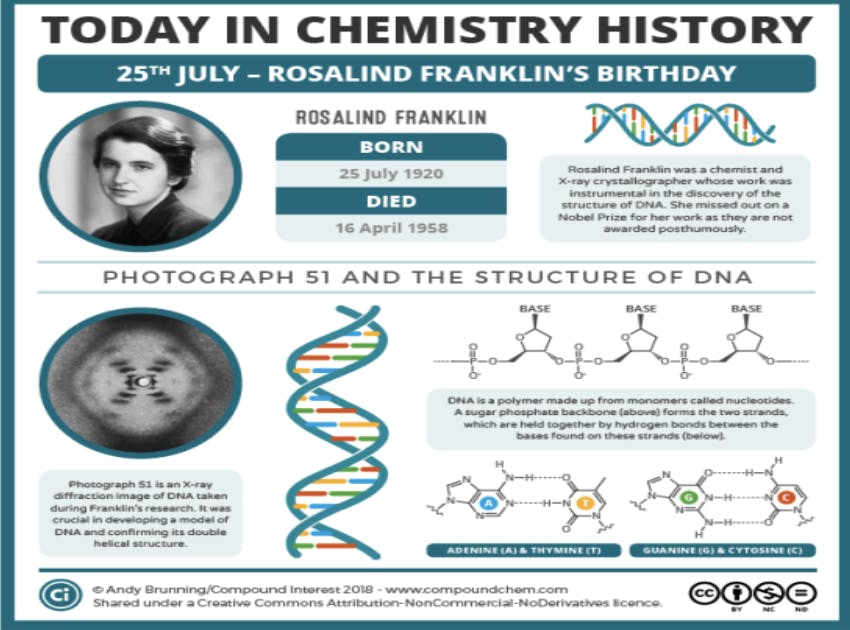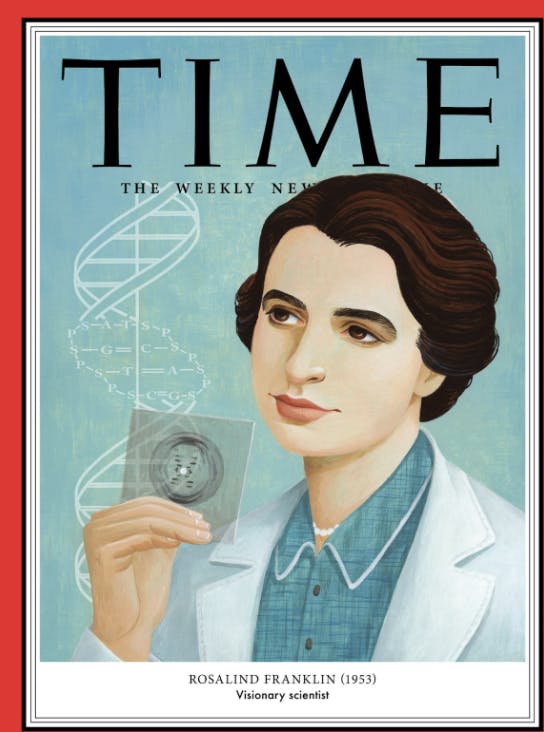TL;DR Science: A Brief Biography of Rosalind Franklin
By Aya Khalaf
January 26, 2022 · 5 minute read
Chemistry
Biology
Biological Engineering
From hundreds of years ago till now, the act of curiosity has always made mankind constantly try to find a purpose for things and question the function and characteristics of their surroundings. It is widely believed that such curiosity has some sort of relation to the goal of satisfying one’s needs and taking advantage of the environment and world humans live in. Many intellectual people contributed to these discoveries and were one of the factors that make our world the way it is today.
When I say intellectual people, I am describing scientists and prodigies who made huge differences and perhaps saved millions of lives throughout the years as a result of their research and analytical skills. One of the many scientists who really made a difference in the world of science, specifically DNA, is Rosalind Elsie Franklin.
Who is Rosalind Elsie Franklin?
Rosalind Franklin was a typical girl living in London, England. She was born on the 25th of July 1920, and died at the age of 37 (April 16, 1958). Franklin attended St. Paul’s Girls’ School before studying physical chemistry at Newnham College, University of Cambridge. After graduating at the age of 21, she received an internship to conduct physical chemistry research in a laboratory in Cambridge. However, World War II took place which disrupted and jeopardized all her plans as she had to serve as an air raid warden. Nevertheless, all of what occurred ended up working in her favor, for she gave up her fellowship to work for the British Coal Utilisation Research Association. Joining the BCURA worked out in her favor as she proceeded to go on with her physical chemistry research but on coal and carbon which she then used for her doctorate thesis.
In 1951, Rosalind registered in the Biophysical Laboratory in King’s College where her studies in DNA started taking place. Little did she know that her interest in such little molecular structures would lead to something far bigger than she ever imagined. She became one of the most well-known chemists who contributed in getting to know the human body and the science behind it.
What is DNA?
DNA, which stands for Deoxyribonucleic acid, is a biological structure found everywhere inside all living things. DNA sits inside a nucleus where each DNA molecule is tightly packaged due to the small size of cells it is found in. This manner of condensed DNA makes the whole structure considered to be called a chromosome. DNA is made of chemical building blocks called nucleotides. These building blocks are made of three parts: a phosphate group, a sugar group and one of four types of nitrogen bases. To form a strand of DNA, nucleotides are linked into chains, with the phosphate and sugar groups alternating.

DNA is a very essential structure in our body. It is the building block of all kinds of proteins which consequently forms the body tissues and the systems until it forms the body as a whole. In other words, DNA is essential for development, growth and genetic diversity. Without DNA, all creatures of all kinds would practically look the same, despite the fact that its absence could perhaps lead to extinction.
Here is a list of what DNA can do:
- DNA provides instructions for making proteins through the messenger RNA which is made through transcription.
- The nitrogenous bases found in the nucleotides of DNA ensure genetic diversity and eliminates the whole idea of identical creatures (unless in case of identical twins)
- DNA supplies the required information so that the cells can reproduce thus allowing for growth and development
- DNA contains information about the genetic diseases that are passed on from an individual to his or her child
As a matter of fact, genes - which form 2% of the DNA structure - play a significant role in determining diseases that could take place inside an individual due to genetic mutation - change in the sequence of nucleotides of the DNA strand.
How did Rosalind conclude her discoveries?
Throughout her years of educational consumption and contributing major findings to the science field. Rosalind had a multitude of achievements which led her to reach very high levels and become the scientist she was back in her day. After her research in the several different chemistry laboratories she worked in, she earned a work scholarship and got recognized by important people in the science community like Marcel Mathieu who directed most of the research in France. He was impressed with Franklin's work and offered her a job as a "chercheur" in the Laboratoire Central des Services Chimiques de l'Etat. There she learned X-ray diffraction techniques from Jacques Mering.

In 1951, Franklin was offered a 3-year research scholarship at King's College in London. With her knowledge, Franklin was to set up and improve the X-ray crystallography unit at King's College. Working with a student, Raymond Gosling, Franklin was able to get two sets of high-resolution photos of crystallized DNA fibers. She used two different fibers of DNA, one more highly hydrated than the other. From this, she deduced the basic dimensions of DNA strands, and that the phosphates were on the outside of what was probably a helical structure.
She presented her data at a lecture in King's College at which James Watson was in attendance. In his book The Double Helix, Watson admitted to not paying attention at Franklin's talk. The data confirmed the 3-D structure that Watson and Crick - two scientists who had worked on DNA research - had theorized for DNA. In 1953, Franklin published papers on her X-ray data in the same Nature issue with Watson and Crick's paper on the structure of DNA.
Franklin left Cambridge in 1953 and went to the Birkbeck lab to work on the structure of tobacco mosaic virus. She published a number of papers on the subject and she made numerous contributions to the science field all the while suffering from cancer.

Sources:
https://www.britannica.com/biography/Rosalind-Franklin
https://www.genome.gov/about-genomics/fact-sheets/Deoxyribonucleic-Acid-Fact-Sheet
https://www.yourgenome.org/facts/what-does-dna-do
https://www.shareyouressays.com/essays/essay-on-the-importance-of-dna/98807
Did you enjoy this article?
About The Author
Aya is a high school rising-senior. She is a huge bookworm, spends too much money on books and is basically a school nerd. Contact her at aya@sciteens.org for article suggestions and book recommendations.